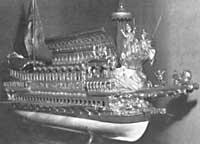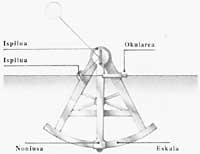Naval History VII: The Warship
Elhuyar Fundazioa

From the loss came the galleon and from the galleon the ship of war. But not suddenly, as the galleon was slowly imposed.
XVII. In the second half of the 20th century there was considerable progress in the manufacture of boat hulls. Until then the builders were mere craftsmen. But soon they saw that the measures of the hull kept a close relationship with the masts and the sails so that the ship had a good performance.
Until then they used the Catalan standard in the manufacture of helmets. The height of the helmet should be half the width and the length three times greater.
Wood was also analyzed. To make the keel, pop and motto, the best thing was the oak cut in waning moon. White oak was suitable for making boards and linings. For manufacturing of castles the fir-tree was the most suitable and for masts pine. To protect the keel and helmet well, special varnishes were made: black soap, grease, sulfur, geminate and human urine.
Holland was the first country to introduce technical innovations in the naval sector, outside the traditional system. Later, these innovations took hold in France and spread everywhere.
Louis XIV of France the minister of King Colbert managed to gather the best builders of the time: Dutch Gedeon, English Deane and Neapolitan Pengland. He founded the academy of marine sciences where he studied mathematics, physics, chemistry and naval architecture. At the same time, forest protection orders were established and the soka-strip was developed a lot. On the other hand, scientists such as Duhamel du Moncau or Pierre Bouguer published navigation treaties.
But the XVIII. The biggest advance of the 20th century was brought by the sextant and the stopwatch. In 1730, American Godfrey and English Hadley had invented the sextant and quickly dispersed to ships everywhere. However, to accurately calculate the length they lacked the proper chronometer, and the English Parliament offered 20,000 pounds for those who invented a 30-second precision chronometer. The year 1780 was the year in which the proper chronometer was finally obtained.
Another profound change was the shape of the ships. The warship castles (bow and pop) lowered and raised the edges. The boat was extended to 80 or 90 meters high. The sails were more extended and used independently, in order to better exploit the strength of the wind.
The weapons were also more and better spread on the warship. Three bridges were placed, one above the other. Some of the castle canyons were brought to the bow and achieved a better balance of the ship while reducing the balance.
However, the XVIII was faster and easier to handle. those centuries. The ship's officers also began to wear uniforms. The life of the sailor, for his part, improved slightly, as he began to feed better. But the level of hygiene and discipline did not improve. Penalties for cutting ears and nose, for example, XIX. In some places it remained until the nineteenth century. Moreover, the plagues were abundant at that time. Scurvy, typhus, dysentery and other similar diseases were present at all times. in 19th century boats. So long put the yellow flag when arriving at the port due to the risk of contamination.
The salaries of the sailors were very low. On the boat there was only a habit of charging a third and when they arrived at the port (not always) they received the other two thirds.

The sailors were difficult to collect because of the problems mentioned. Those who were addicted to minds or goldsmiths wanted to go to the sea. Some also began to work as sailors to get rid of prison. But they were all few. Nelson's fleet, for example, had 150,000 people and hence the shortage of sailors. They carried forcibly.
On the other hand, most of the time the people of the boats died of evil. For lack of cleanliness and hygiene, nine out of ten men of the sailors who died at work disappeared because of scurvy, concave or some other epidemic. XVIII. In the 19th century, British admiral James Cook greatly modified the hygiene of the boats. He used the lemon against the scurvy and gave other rules of order.






